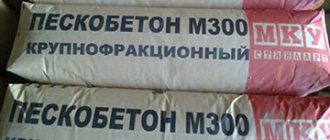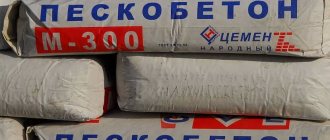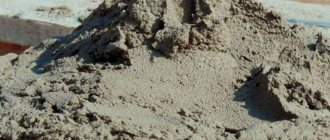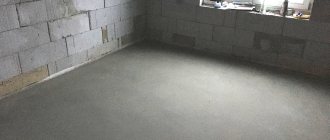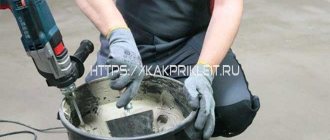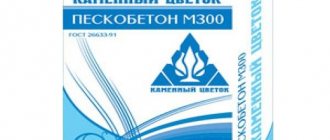What important nuances should you know about sand concrete brand “Rusean Luiks” M300
Purchasing a high-quality building mixture for preparing the mortar is a guarantee of the reliability and durability of the coating. For many years now, Rusean M300 sand concrete has not lost its popularity, which is rightfully considered the standard of durable dry mixes.
It contains coarse quartz sand, Portland cement, and plasticizers. These ingredients make it non-shrinking, easy to mix, and increase the density of the solution.
Where is it used?
Rusean luix is used during many construction processes. Among them:
- Finishing of the façade of buildings.
- Installation of basement materials.
- Pouring concrete screeds.
- Formation of a wear-resistant monolithic floor.
- Alignment and sealing of seams. Correction of deficiencies in cement and concrete mortars.
- Construction or reconstruction of foundations of any type.
- Carrying out repair work on concrete surfaces.
Therefore, it is convenient to work with this material both inside residential and industrial premises, basements, and outside buildings to decorate their bases and pour a solid foundation.
Brightness, individuality and beauty of the building with the help of Rusean facade plaster
Russean facade plaster is a dry mixture intended for finishing facades, plinths and other external surfaces, as well as rooms in which there may be different levels of humidity. Thanks to the application of high-quality material, the building acquires an attractive appearance and protection from fire, destruction, and weather damage. The practical material is available in a wide color palette and with a variety of textures. You can apply the solution using equipment or manually yourself.
- Composition and characteristics of Rusean facade plaster
- Pros and cons of facade materials
- Mixture preparation, application, consumption
Composition and characteristics of Rusean facade plaster
Rusean facade plaster includes several components. This:
- high quality cement;
- plasticizers that improve plasticity;
- fractional sand;
- lime.
The mixture is used for leveling brick and concrete surfaces, aerated concrete, and stone. It is used for processing and sealing seams and cracks, repairing concrete walls, rough leveling and plastering surfaces indoors and on the outside of buildings.
Material properties
The important properties of sand concrete include:
- resistance to sudden temperature changes;
- not affected by corrosion;
- the finished solution quickly hardens and hardens;
- spreads evenly over the entire treated surface;
- peeling or tearing of the coating is excluded.
The recommended temperature range for working with the material is from +5 to +500C. If the indicator is below zero, the solution will harden much more slowly.
To prepare with additional ingredients, you only need water.
It is important to note that the Roussean Luix mixture is poured in the required quantity into a container with water prepared in advance. Reverse actions are fraught with the formation of lumps.
Often, manufacturers pack it in bags of 40 kg, less often 25 kg each.
Performance characteristics
When purchasing mixtures from an official manufacturer, the client receives a product that has a certificate of conformity.
A list of the main technical characteristics of the material is given in the table below:
| Type of characteristics | Index |
| Color | grey |
| Frost resistance (number of cycles) | 50 |
| Maximum fraction, mm | 5 |
| Delamination, % | 4,9 |
| Compressive strength, MPa | 30 |
| Water consumption per 1 kg of mixture, l | 0,12 – 0,15 |
| Density of the finished solution, kg/m3 | 2100 – 2200 |
| Water holding capacity | 95% |
| Recommended layer thickness, mm | 50 |
| Solution mobility | PC3 |
| Drying time, hour | 24 |
| Expiration date, days | 180 |
The prepared mixture should be used within the next 2 hours after mixing, otherwise it will simply harden.
Sand concrete M300 brand Rusean
Rusean sand concrete is a representative of modern high-quality dry construction mixtures. This non-shrinking composition is widely used in the construction of foundations, creating brickwork, self-leveling floors and durable concrete screeds. Sand concrete M300 is considered a standard grade of strength and reliability.
Compared to other materials, it is characterized by a number of advantages that distinguish it:
1. The Portland cement included in the composition gives high strength.
2. Optimal viscosity is enhanced by sand.
3. Anti-corrosion properties, resistance to deformation and wear are due to the presence of synthetic additives.
4. High drying speed.
5. High density.
6. Frost resistance.
7. Waterproof.
8. Environmentally friendly.
Due to its increased strength, sand concrete M300 is used in the construction of large industrial complexes and the construction of domestic and utility buildings. You cannot do without this universal dry mixture when constructing garages and large basements. It is suitable for both external and internal work. It should be noted that this is a very plastic material that has a short hardening period. Its special operational and physical properties make it possible to use it in buildings and structures of any level of complexity and for various purposes. Sand concrete M300 is in demand in the manufacture of monolithic slabs, reinforced concrete structures and wall panels.
Sand concrete preparation technology
The packaging contains information about the scope of application, composition, storage conditions and preparation technology. Carefully add the required amount of clean water to the container with the dry mixture and mix everything thoroughly until a homogeneous mass is obtained. To do this, you can use a low-speed mixer or a drill with an attachment. Leave for 5 minutes and then mix again, the solution is ready. When preparing, it is necessary to observe the proportions of water, since its excessive amount reduces the strength and leads to the formation of cracks. And to prevent hardening of the top layer, the composition is periodically shaken.
When pouring the floor, the solution is thoroughly compacted. In practice, the consumption per 1 m2 of dry mixture screed is 20 kg with a layer height of 10 mm. It is advisable to make the surface leveling layer 10-50 mm thick. If 100 mm is poured, it is recommended to lay reinforcing mesh. After 24 hours it will gain strength, and after 2 days it can already be used. Due to the fact that M300 sand concrete has a short hardening time, it is often used in emergency situations that require an immediate response. In addition, it is used to level cement-sand and concrete bases, eliminate defects in pouring concrete products, and also make high-strength screeds and carry out various installation and construction work.
Specifications
| Name of mixture parameters | Meaning |
| Color | Grey |
| Delamination | 4.9 % |
| Maximum fraction | 5.0 mm |
| Consumption at a layer thickness of 10 mm | 20-22 kg per 1 m2 |
| Mobility, mm | 8.3 Pk-3 |
| Recommended layer thickness | 50 mm |
| Frost resistance | 50 cycles |
| Compressive strength | 30 mPa |
| Water holding capacity | 95 % |
| Drying time | 24 hours |
| Best before date | 180 days |
The prepared solution is applied to a dry surface, which is previously cleaned of grease, dust, lubricating oils and various paints and varnishes. Remove fragile, crumbling areas. If the area being treated is hygroscopic, then before applying sand concrete, it must be moistened or primed.
The solution is poured onto the surface and distributed evenly throughout the entire volume. To do this, use a grater, lath or spatula. To prevent rapid evaporation of moisture and the negative effects of drafts, everything is covered with film or tarpaulin for 3 days. During breaks between work or after completion, equipment and tools are washed with water. If the remains of sand concrete harden on them, the mixture can only be removed mechanically, which will significantly affect the quality of the devices used. The work requires dry conditions, relative humidity should not exceed 80%, and the ambient temperature should be from +5 to +30 °C.
The packaging contains instructions from which you can find information on using concrete. It indicates the consumption of dry mixture M300 per 1 m2 of screed with a thickness of 1 cm.
Plastering surfaces and laying bricks
The volume of sand concrete consumed to level walls is slightly different from floor screed work. This is explained by the fact that surfaces in a vertical position generally do not have significant deviations. When calculating the required volume of the mixture, the same method is used as for floor screed.
Calculating the required amount of concrete mortar for laying the internal partitions of a building is not so difficult if you know their height and width. Based on these dimensions, the entire area of the joints is determined, taking into account that the standard thickness of the interlayer is 12 mm. On average, the consumption for bricklaying is 2.3-2.6 kg/m2.
You can purchase M300 sand concrete for the entire scope of work in bulk, which will significantly reduce the cost of purchasing and transportation. It is recommended to buy in bags from the manufacturer, which is a guarantee of quality, compliance with the specified grade and weight of the bag. Rusean building mixtures are packaged in containers of 40 and 50 kg. Their price depends on the brand; the higher it is, the greater the cost. Comparison with other brands:
| Sand concrete | Cost, rubles |
| Rusean, 40 kg | 145 |
| Luxe, 40 kg | 140 |
| Finstroy, 40 kg | 100 |
| Stone flower M300, 50 kg | 130 |
| MKU, 50 kg | 95 |
| MAXS, 50 kg | 118 |
Bags of sand concrete must be stored at temperatures from +5 to +30 °C and under conditions that prevent damage to the integrity of the packaging and exposure to precipitation.
Advantages of using sand concrete
These include:
- Resistance to high humidity.
- The versatility of the material composition. Suitable for construction in any field of activity, various household needs.
- Not afraid of low temperatures. Has a high frost resistance.
- Convenient solution preparation.
- Does not crack. Lays flat on the surface.
- Sand concrete does not shrink even under the influence of large mechanical loads. Can withstand 300 kg per 1 cm2.
- Portland cement provides high strength to the mixture.
- Quartz sand increases the viscosity of the solution.
- Plasticizers in M300 make it resistant to various types of deformation and rapid wear.
- Dries quickly.
- Environmentally friendly material.
- High level of density.
- Affordable price.
What disadvantages can you encounter?
No significant deficiencies were found in sand concrete. Except for the possibility of purchasing a fake at a lower cost. To prevent this from happening, when purchasing, you should always pay attention to the presence of a certificate of conformity.
Another unpleasant surprise can be the formation of lumps in the mixture. But this is more likely not a minus of the material, but a violation of storage rules.
Bags with the mixture should be stored in dry, ventilated areas at an internal air temperature of +5 to +300 C.
Delivery by our transport is carried out in Moscow and the Moscow region
In this case, payment can be in two ways:
Payment upon delivery (This will allow you to be convinced of the proper quality of our building materials, and then make a payment to our driver)
Payment by card (If the transfer is planned upon delivery of building materials, in this case we take an advance payment equal to the delivery amount and + 1% commission for withdrawing money)
Prices for delivery of building materials in Moscow:
| Product weight | Delivery price |
| Up to 1.5 tons | from 2100 rubles |
| Up to 2.5 tons | from 2600 rubles |
| Up to 5 tons with crane | from 6800 rubles |
| Up to 7 tons with crane | from 6800 rubles |
| Up to 8 tons with crane | from 7800 rubles |
| Up to 12 tons with crane | from 11,000 rubles |
Prices for delivery of building materials in the Moscow region:
| Product weight | Delivery price |
| Up to 1.5 tons | from 1900 rubles + 30 rubles per km |
| Up to 2.5 tons | from 2500 rubles + 30 rubles per km |
| Up to 5 tons with crane | from 6800 rubles + 50 rubles per km |
| Up to 7 tons with crane | from 6800 rubles + 50 rubles per km |
| Up to 8 tons with crane | from 7500 rubles + 50 rubles per km |
| Up to 12 tons with crane | from 9500 rubles + 50 rubles per km |
We also provide services:
| Ascent to the apartment (availability of a freight elevator) | Unloading price |
| Up to 100 kg | 250 rub. (no more than 2 meters in the apartment) |
| From 101 to 500 kg | 1 rub. for 1 kg (no more than 2 meters in the apartment) |
| From 501 to 10000 kg | 0.9 rub. for 1 kg (no more than 2 meters in the apartment) |
| Ascent to the apartment (without elevator) for each floor | Unloading price |
| Up to 30 kg | 2.6 rub. (no more than 2 meters in the apartment) |
| From 31 to 60 kg | 2 r. for 1 kg (no more than 2 meters in the apartment) |
| From 61 to 100 kg | 1.6 rub. for 1 kg (no more than 2 meters in the apartment) |
| From 101 to 500 kg | 1.3 rub. for 1 kg (no more than 2 meters in the apartment) |
| From 501 to 1000 kg | 1 rub. for 1 kg (no more than 2 meters in the apartment) |
| From 1001 to 10000 kg | 0.9 rub. for 1 kg (no more than 2 meters in the apartment) |
Unloading on the ground 0.5 rubles per 1 kg
Lifting of Drywall, Profile, OSB, and other dimensional Materials are calculated separately with the manager
Return Policy
- Returns are made within 14 days from the date of purchase. The goods are delivered to the shipping warehouse (check with managers) or you can use the delivery and loading service. Price according to price or individually.
- Products sold by the meter (measured, cut), damaged, expired, or in poor presentation are not subject to return.
When unloading and lifting, cleaning the entrance, removing garbage and other ensuing consequences after lifting the building material are not included in the price. Prepare in advance for the service you ordered. Thanks for understanding !
The procedure for preparing a high-quality solution
A description of the step-by-step instructions for preparing a solution of the correct consistency is as follows:
- It is necessary to prepare water at room temperature, calculating that a 40 kg bag will require 7 liters.
- The treated area is cleared of debris and dirt.
- Water is mixed with sand concrete manually or using an electric drill with an attachment or a construction mixer. Thus, the time for mixing will be reduced significantly.
- The finished solution is a plastic mass of uniform consistency without lumps.
- Allow to stand for 10 minutes and stir again.
- The resulting mixture is applied with a trowel to the surface to be treated in an even layer.
If the surface to be treated has a high degree of hygroscopicity, then it should be covered with a G5-G7 primer. It can also be used between layers of mortar - this will ensure its high-quality adhesion.
To achieve a perfectly flat surface, you can use a provil. Depending on the air temperature and humidity, the time for complete hardening of the solution ranges from 2 to 6 hours. It is recommended to subject the coating to mechanical stress no earlier than after 2 days.
Consumption per 1 m2 of sand concrete with a layer thickness of 10 mm will be 22 kg.
Tools used for mixing the solution should be immediately washed with water, otherwise parts of the mixture will harden and removing them will be problematic.
Surface preparation
Apply to a solid brick or concrete base. Before using the solution, any existing dirt, dust, or peelings should be removed from the surface. Prime the surface. For rough surfaces, use Rusean Deep Penetration Primer. For smooth, non-absorbent concrete surfaces, use Betonkontakt Rusean.
SURFACE PRIMING IS MANDATORY!
Recommendations
If the plastered surface will be covered with wallpaper or other coatings, then it can be puttyed after the plaster has completely dried. If the surface is to be painted, the plastered surface must be left for 28 days before filling. During this period, thread-like shrinkage cracks may appear, which are safe and do not lead to peeling of the plaster. The presence of thread-like shrinkage cracks is not a defect.
The recommended thickness of the solution applied at a time is 10-20mm. If it is necessary to apply a thick (more than 2 cm) layer of plaster, it is better to apply the solution in several stages. Before applying subsequent layers, the previous one is allowed to fully set. The applied solution is leveled with a rule, allowed to dry a little and rubbed in with a grater.
Do not apply to plaster base.
Do not use for facade work, use “RUSEAN FACADE PLASTER”.
Tips from experienced builders
When purchasing material, it is important to remember:
- When calculating the mixture consumption, the type of construction work should be taken into account. Because repairing a floor requires much less mortar than pouring a full screed.
- Excess water in the solution will lead to the formation of cracks and reduce the strength of the coating. Lack of water will cause uneven consistency and rough surface.
- When working with this material, you need to use safety glasses and gloves. Avoid getting the mixture into the eyes and respiratory tract.
- The optimal operating humidity is no more than 80%.
- After pouring, the mixture must be compacted.
- Treatment of areas over 100 m2 is carried out with the addition of a reinforcing layer. The joints are also reinforced with reinforcement bars.
- The average consumption of sand concrete for bricklaying is from 2.3 to 2.6 kg per 1 m2.
If capital construction is planned, then the required number of bags of mixture should be calculated in advance. Buy it in bulk at the official point of sale. So, you will be able to save a little on the purchase and transportation of products.
Rusean M-150 plastering for machine application 40 kg
price with VAT 195 ₽ per piece buy in 1 click
Surface area - m2 Application thickness - mm
Free delivery from 20 tons in Moscow and Moscow Region
Next delivery: the day after tomorrow
Weight
: 40 kg
Consumption per m2
: 17.5 kg (with a thickness of 10 mm)
Approximate consumption 1 piece
: 7 m2
Manufacturer
: Rusean All characteristics
Delivery to underground parking possible
grey, plastering and wall repair, for interior and exterior work, RN+MN
Sale of dry plaster mixture Rusean M-150 for machine application 40 kg with delivery in Moscow
Rusean M-150 is a dry type of construction plaster mixture, which includes Portland cement and sand, plus a number of mineral fillers that improve the technical characteristics of the plaster.
